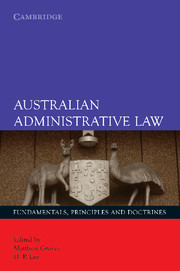Book contents
- Frontmatter
- Contents
- Foreword
- Preface
- About the contributors
- Table of cases
- Table of statutes
- 1 Australian administrative law: The constitutional and legal matrix
- 2 Administrative law in Australia: Themes and values
- 3 The public/private distinction in Australian administrative law
- 4 Australian administrative law: The human rights dimension
- 5 Administrative tribunals
- 6 Australian Ombudsman: A continual work in progress
- 7 Freedom of information
- 8 Delegated legislation
- 9 The concept of ‘justiciability’ in administrative law
- 10 Standing
- 11 Reasons for administrative decisions: Legal framework and reform
- 12 Relevant and irrelevant considerations
- 13 Improper purpose
- 14 Reasonableness, rationality and proportionality
- 15 The ‘no evidence’ rule
- 16 Failure to exercise discretion or perform duties
- 17 Procedural fairness: The hearing rule
- 18 The doctrine of substantive unfairness and the review of substantive legitimate expectations
- 19 The impact and significance of Teoh and Lam
- 20 The rule against bias
- 21 Jurisdictional error without the tears
- 22 Privative clauses and the limits of the law
- 23 Administrative law judicial remedies
- Endnotes
- Index
17 - Procedural fairness: The hearing rule
Published online by Cambridge University Press: 05 June 2012
- Frontmatter
- Contents
- Foreword
- Preface
- About the contributors
- Table of cases
- Table of statutes
- 1 Australian administrative law: The constitutional and legal matrix
- 2 Administrative law in Australia: Themes and values
- 3 The public/private distinction in Australian administrative law
- 4 Australian administrative law: The human rights dimension
- 5 Administrative tribunals
- 6 Australian Ombudsman: A continual work in progress
- 7 Freedom of information
- 8 Delegated legislation
- 9 The concept of ‘justiciability’ in administrative law
- 10 Standing
- 11 Reasons for administrative decisions: Legal framework and reform
- 12 Relevant and irrelevant considerations
- 13 Improper purpose
- 14 Reasonableness, rationality and proportionality
- 15 The ‘no evidence’ rule
- 16 Failure to exercise discretion or perform duties
- 17 Procedural fairness: The hearing rule
- 18 The doctrine of substantive unfairness and the review of substantive legitimate expectations
- 19 The impact and significance of Teoh and Lam
- 20 The rule against bias
- 21 Jurisdictional error without the tears
- 22 Privative clauses and the limits of the law
- 23 Administrative law judicial remedies
- Endnotes
- Index
Summary
The essential requirements of procedural fairness are fairness and detachment. Those requirements find expression in the two rules of procedural fairness. The first is the hearing rule (audi alteram partem), which is the requirement to give notice to the person affected by a decision that a decision is to be made, to disclose information or material on which the decision maker proposes to rely, and to allow an opportunity to put a case. The second is the rule against bias (nemo debet esse judex in propria sua causa), which is the requirement that the decision maker be free of actual bias or prejudgment, or the perception of prejudgment.
The hearing rule is a broad topic that could potentially cover a vast range of procedural requirements that arise from the principles of procedural fairness. This chapter addresses four aspects of those requirements: (a) the application of the hearing rule; (b) the exclusion or limitation of the hearing rule; (c) the content of the hearing rule; and (d) the consequences of breach of the hearing rule.
It is important to note at the outset that the term ‘hearing’ does not refer just to that part of a decision-making process that may take the form of an oral presentation of evidence and argument. Unlike judicial decision-making in an adversarial system, which has its primary focus on the formal oral hearing of evidence and submissions, administrative decision-making adopts many forms, and need not necessarily involve an oral component.
- Type
- Chapter
- Information
- Australian Administrative LawFundamentals, Principles and Doctrines, pp. 265 - 279Publisher: Cambridge University PressPrint publication year: 2007



